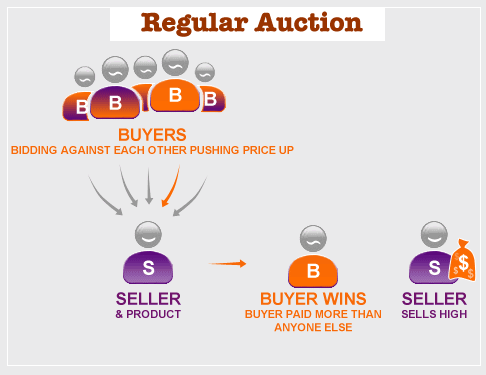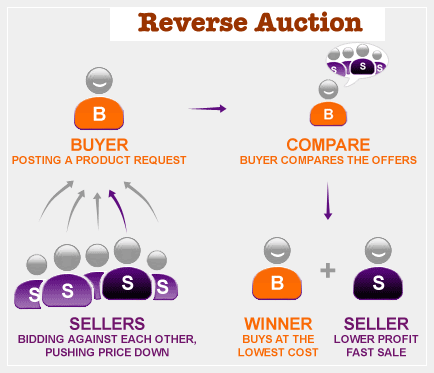A Co-Production of @steemship and @the-alien
By Richard Kaplan and Adil Elias

Special thanks to Tom @donkeypong for suggesting this topic and connecting the two of us to write it together. Collaborative writing is a lot of fun. It’s been my privilege to work with Adil, @the-alien, who is a smart and gifted writer, and a great team player. I hope you’ll read and enjoy his other posts. He’s getting half of the payout from this one! -Richard
Smart Voters Make the Most Money
Your votes can make you money. But the most recent changes to curation rewards mean that you won’t make as much from the type of voting you did in the past. What used to be an excellent strategy just a few days ago will be much less effective under the new version of Steemit. In fact, it just may cost you a significant amount of money.
We are here to explain the new curation rewards system, and especially its reverse auction format, which is included in both the 0.8.2 and 0.8.3 proposed versions of Steemit (EDIT: and in fact, we are now being told that this reverse auction voting reward has already been implemented, so understanding it is even more important). By understanding how this reverse auction voting system works, you will be well positioned to vote smart…and profitably.
Note: For a good recent update on the 0.8.x fork issues, you can read this post: @pharesim/curation-reward-fork-discussion-updates

As it is often the case with most technological advancements, everything keeps changing and you just have to keep up with the updates, because otherwise you’ll find yourself beautifully prepared to compete in a system that no longer exists. We don’t want that to happen to you, and so we have written this short guide to help you continue to vote profitably. It’s always good to vote for posts you like and to reward good authors and artists, even those who are not yet popular. But because most people also are hoping to be paid for voting, we need to understand the curation rewards system also.
Once you know how the new rules work, we think you’ll appreciate that they put everyone on an even playing field. Assuming this system is implemented, as we expect, you will have just as much chance to profit from voting as anyone else. This is a unique opportunity that exists nowhere else on the Internet, nowhere else in social media, and certainly does not exist in any government-run election anywhere in the world. Unless, of course, you are financing one of the candidates.
You can make good money from voting. But only by voting smart!
I thought I needed a FastPass (Fancy Bot) or Trigger Finger. What Has Changed?
As you probably know, Steemit pays users to post and to curate. In the past, “curation” meant “voting”, and the most profitable strategy was to vote as EARLY as possible on any post that seemed likely to become popular. This is a good system, because it rewards people for discovering good posts and bringing them to the community’s attention.
However, under Steemit’s old rules, voting bots could jump to the front of the line, casting the most profitable early votes on a promising post. (A bot is a simple software program that runs automated tasks, like voting faster than you can on something that a popular Steemit writer has just posted.) While we are not passing judgment on bots, which do fulfill a certain purpose, the people using bots certainly have held an advantage so far.

We can compare this to buying a FastPass at Disneyworld or another amusement park; many such parks offer an advantage pass for those who buy a membership or pay extra. While average people have to wait in lines for popular rides and attractions, FastPass holders can jump to the front of the line because they paid extra for that privilege.
Under Steemit’s new curation rewards system, which was recently announced, everyone gets a fair shot.
Until recently, you were highly incentivized to vote early on soon-to-be popular posts. The logic behind that was very simple. If you were the first user to upvote something that becomes popular later on, you would get a larger payout in comparison to the rest of the upvoters.
But now there is a new system set to debut, and while it’s still true that voters get paid a big chunk of the money from each post, there will be another variable added to the equation. From now on, all curation rewards earned by voting in the first 30 minutes are to be shared with the author. If you vote right away after the post is submitted, then the author gets most of your reward, but if you wait longer you get more. Of course, others can jump in during that time, so if you wait longer to vote, the consequences can be both positive and negative. On the one hand, you make a higher percentage of the payout by waiting as long as possible within that 30 minute period. But then again, other people may vote ahead of you, reducing your payout.
This is a reverse auction system, inviting everyone to jump in any time with your vote during the first 30 minutes following a post’s submission. You will get a different share of the reward depending on when you vote. And you need to decide when is the most profitable time to vote, since others may jump into line ahead of you! Before we examine this in more detail, let’s take a direct quote from the new updated protocol:
“Starting *TODAY all curation rewards earned by voting in the first 30 minutes after a post is made will be shared with the author. If you vote immediately after a post is made, then 99.94% of the curation reward will go to the author. If you vote after 15 minutes, then 50% will go to the author. Any votes made 30 minutes or later 100% will go to the curator. This only applies to the curation rewards. The author still gets at least 50% of the total rewards.”
Source: @steemitblog/steem-0-8-0-released
We will explain this system more in a moment. And we will show you how to update your voting behavior to take the best advantage of it. But first, let’s address one aspect of the @steemitblog post above. It said "TODAY", and in fact this portion of the rewards system went into effect on June 24th. Do not despair if you’ve been voting “wrong” so far since it probably has not cost you much money yet; let’s just focus on getting it “right” going forward.

Bot Test. Beep Beep. You Passed.
If you’re still reading this article, we can assume that you are not a bot. That means you get to exercise your own human judgment about the best time to vote on a new post. We will help you understand the possibilities. From there, you can make your own decisions.
You will still be competing with voting bots, but now that competition will last as long as 30 minutes, rather than lasting a couple of seconds, as was the case before.
How long should you wait? Ah, the game begins.
What is a Reverse Auction System?
Most people are familiar with traditional auctions. A seller lists a product for sale and buyers compete to purchase it. The buyers drive up the price on one another, so more competition yields a higher price for the seller. A regular auction benefits the seller more than the buyers.


In a reverse auction, the tables are turned. It is the buyer who announces a need, while the sellers compete for that buyer’s business. Procurement systems, both in government and in business, often use a reverse auction system. They announce a need and let suppliers or labor brokers compete for the lowest bid that still makes financial sense. The competition results in lower prices, as each seller is trying to beat the others’ prices to get a deal done.
Less money is wasted on artificial profits, and if those resources are put to more productive use, then this system has the power to help create a more efficient economy.
Fortunately, Steemit is its own economy and no resource needs to be wasted. It’s not exactly as if any money saved from voting goes to some greedy corporation. It still goes to author and curator rewards, which both remain quite generous. Implementing the reverse auction system for voting simply provides bots with a little more competition over a longer period of time (as long as 30 minutes instead of just seconds), and gives people a little more time to read posts before they vote. So determining the best price point is now purely depending on the free market economy. And that price point will be settled by when people (and bots) decide to vote.

Recapping Steemit’s New Change and What It Means to You
• If you vote immediately after a post is submitted: The voter gets almost zero, the author gets nearly 100%.
• If you vote 15 minutes after a post has been submitted: The voter gets 50% of the curation reward, and the author gets the other 50%.
• If you vote 30 minutes (or later) after a post is submitted: The voter gets 100% of the curation reward.
The time-reward relationship is linear. The reward is progressively changing throughout that first 30 minutes. So the 15 minute mark is just an example; there is no special milestone occurring at 15 minutes. The only real milestone is at 30 minutes, when the voter hits the 100% curation payout. Until then, the author’s portion of the reward is declining and the voter’s portion of the reward is increasing, the longer you wait to upvote the post.
That means that you could jump in at any point with a vote, whether it’s at the 2 minute or 10 minute or 18 minute or 23 minute or 29:59 minute mark, or at any other point, and you would land on a point where your split with the author would be very predictable.
Why wouldn’t you wait until 29:59 to push the upvote button? Because others may vote much sooner. They are comfortable sharing a large piece of the pie with the author. And you might want to beat them to claim your earlier spot in line. It still pays to discover posts before others do. So you will need to watch and learn and ultimately decide for yourself when it is most profitable to vote.
So When is the Best Time to Vote?
Damned if we know! If we told you when to vote, we would be fools. This is a complex system that is dynamic and market-based, it is brand new, and people will use their knowledge of it to reach very different decisions.
Some will vote early, comfortable with taking a lower profit in exchange for an early share of curation rewards. Others will try to vote as late as they possibly can to maximize the return. But this will only work if most voters do not press their upvote buttons earlier, in which case there won’t be many rewards left for those who vote late. Bots will guess at the most economical time to vote, and people will try to beat the bots, then bots will try to outsmart the people, and it will set off a race to make Steemit as efficient a platform as possible.
For both bots and people, the actual voting time will be a shifting target because smarter voters will not stick to the same script very long. Don’t get lazy or someone else may come along and undercut your “price” by voting earlier than you!
In time, patterns will emerge. We probably will see a time range where most of the voting takes place. It may be closer to the beginning of that period (shortly after the post is submitted) or most voting could settle around a point that is nearer to the end (of the 30 minute period).
And don’t forget the voters who don’t care if they are paid. They will upvote posts they like, right away if they find them, and will be glad to let the author take a big cut of their reward. We hope that everyone will continue to use some of their votes to reward new and deserving authors. This is not all about making money.
Only one thing is certain: it doesn't make financial sense to vote immediately on posts any more. That gives you a little more time to read them and vote for what you like, not just automatically hitting the upvote button for anything a popular author submits. If you’re trying to profit, you have to wait at least a little while, until not all of your curation reward goes back to the author. Keep an eye on how this system develops and how people behave.
And don’t take it too seriously. Remember that it’s all supposed to be fun. Even if you miss the perfectly optimal time to vote, you’ll still make money by voting.
Making money for having a good time? Who could ask for more!
-Peace, Richard @steemship and Adil @the-alien
